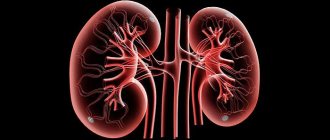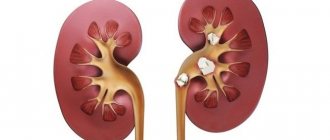According to statistics, doctors diagnose about 40,000 cases of kidney cancer every year. This disease progresses at an average rate and is not considered aggressive, but without proper treatment it can be fatal. And quite often stage 4 kidney cancer with metastases is detected. The tumor does not make itself felt for a long time, and only a few undergo annual examinations for prevention.
Modern medicine is developing rapidly, but cancer still remains one of the main problems of humanity. Malignant tumors can affect any organ, and the cause of their appearance has not yet been fully determined. The success of therapy depends on how early the disease is detected and when treatment is started.
Survival prognosis
If stage 4 kidney cancer with metastases is diagnosed, how long you live depends on many factors:
- patient's age;
- the patient's emotional state;
- presence of concomitant diseases;
- on the professionalism of doctors and equipment of the clinic;
- level of proposed therapy.
Table: 4 stages of cancer, how long patients live
The table shows the average percentage.
Unfavorable disease progression and survival
It is possible to determine the progression of the disease, despite treatment, by certain signs:
- The status in the “somatic” section on the Karnofsky scale is less than 80% (it is permissible to check it yourself, but more often the doctor himself determines the percentage).
- The level of lactate dehydrogenase (LDH) is one and a half times higher than normal.
- According to the results of the tests, in comparison with previous ones, an increase in calcium in the blood was detected.
- Decreased hemoglobin.
- Thrombocytosis (increased platelet levels).
The signs on the list determine how long a person has left to live. There are three groups of patients. Survival prognosis differs by group. A bad prognosis is the presence of at least 3 options from the list above. Without surgical interventions and serious treatment, a patient in this group has no more than 6 months to live. The moderate prognosis group guarantees the patient about 14 months of life. Treatment is actively ongoing. A patient without signs of disease progression is included in the favorable prognosis group and given 30 months to live.
Types of renal cell carcinoma (RCC)
- Clear cell – accounts for about 75% of RCC cases. The cells appear pale or transparent.
- Papillary (chromophilic) - makes up about 11% of RCC. This type of cancer cell forms projections, and when they absorb certain dyes, they turn pink.
- Chromophobic - accounts for about 7% of RCC cases. They look pale and much larger.
- Oncocytic - accounts for 4% of all cases of RCC.
- Collecting duct - a rare type, accounts for less than 2% of all cases of RCC.
Causes
Malignant degeneration of cells is caused by a genetic failure, when instead of normal specialized structures, sick, deformed ones are formed, unable to perform the main functions of the organ to which they belong. External and internal factors that become causes of cancer can provoke gene mutations in humans:
- External influences from chemical and physical damaging agents lead to changes in the normal activity of cells. Under the influence of radiation and chemicals, the genetic code changes, active division occurs, organ tissues grow, but their structure is disrupted. The process can develop rapidly, quickly leading to the passage of all stages of cancer and leading to death. With early detection, a favorable outcome is possible, but the pathological code can remain in the cellular memory and be passed on to subsequent generations, and the child will be at increased risk.
- Internal causes of tumor development are associated with improper activity of the immune system, which begins to perceive normal body structures as pathogens. Healthy cells are actively destroyed by internal protective forces, while hyperplasia processes are launched to replenish the functions of the organ. Due to rapid division and growth, cellular structures do not have time to undergo specification, and the functions of the organ are lost.
Thus, the causes of oncology are closely related to heredity, lifestyle and external influences. Poor environmental conditions, bad habits and cases of cancer in the family increase the risk, but with timely detection, cancer can be successfully treated.
Symptoms
Kidney cancer may present with symptoms in the local area of the kidney, or with signs and symptoms in other connective tissues or organs. Spread to other organs and connective tissues is called metastasis.
Symptoms resulting from local tumor growth include hematuria (blood in the urine), abdominal pain.
Hematuria is the most common symptom and presents either as gross hematuria, where blood is visible in the urine, or as microscopic hematuria, where blood is detected only through laboratory tests. Any presence of blood in the urine should be examined.
Symptoms caused by metastases include: fever, weight loss, and night sweats (wet bed that requires changing clothes or sheets). Other symptoms include hypertension, low back pain, elevated blood calcium, and liver problems. These symptoms are caused by chemical signals from cells in the blood and the body's response to them.
Relapse
The worst thing for a person who has gotten rid of tumors and metastases is a relapse. The disease progresses after several weeks or months of calm. Relapses cause death in 8 cases out of 10. They are caused by an incorrect approach to treatment, which only paused the disease without eliminating the source.
The patient's body begins to fail the person. Other health problems arise, immunity decreases, and it is easier for a person to catch colds and pneumonia. This is possible if the body is intolerant to drugs.
The danger lies in the spontaneity and unpredictability of development. A relapse can take a person by surprise. Sometimes it is not possible to identify their real cause. Medicine does not provide clear answers on how to avoid relapse after successful tumor removal. The patient should prepare for everything and count on luck. Sometimes the cause is an unexpected error or a virus that is not dangerous to a healthy person.
Diagnostics
The use of CT and ultrasound improves the early diagnosis of kidney cancer. A large number of kidney cancer cases are discovered by chance while working on another problem. If the tumor is detected earlier, the likelihood of recovery will be higher.
Other laboratory tests such as a complete blood count and urinalysis may be used to evaluate your overall health and the extent of the cancer. In addition, a chest x-ray and bone scan may be done to ensure that metastasis to the lungs and bones has not occurred.
To obtain a correct diagnosis of kidney cancer, a biopsy is often done by inserting a needle into the tumor mass. The most appropriate surgical approach is determined individually for each patient at the cancer center.
Cytological analysis consists of examining urine under a microscope. This test can help indicate the development of cancer at an early stage. Documents containing the diagnosis must be retained.
Consequences of the operation
Studies show that 30-40% of patients after surgery experienced consequences from the operation. They can appear in 3-4 years, in the next week or day. It all depends on the course of the disease, the patient’s condition and the stage of the cancer. New lesions appear in the kidney, liver, lungs and lymph nodes. After the operation, the patient is observed by a doctor and undergoes regular examinations for the rest of his life.
Life expectancy depends on the period of manifestation of the consequences. It would be good if they occurred after surgery - this increases the patient’s chances. Consequences that appear after a few years can cause serious illnesses without the possibility of complete recovery of the body. Cases of successful outcome were recorded in the first and second groups. They make up 8% of all patients. But without treatment, the prognosis worsens.
Distribution methods
If tumor growth occurs, the cancer may affect the main renal veins, the large vein that returns blood from the lower body to the heart (IVC), or to other organs, usually the adrenal glands, which are located at the top of the kidney.
Kidney cancer can also spread by accessing the lymphatic system. Lymph is the body's complete circulation system (sort of like a circulatory system) that drains to various lymph nodes. When cancer cells have access to the lymphatic system, tumors can develop in the lymph nodes.
Tumors, especially large ones, can gain access to the bloodstream and spread to the lungs and bones, most often a kidney tumor spreads to the ovaries through the testes or ovarian veins, which are in close proximity to the kidney.
There are 4 stages of kidney cancer:
- Stages 1 and 2 describe cancers in which the tumor is still in the kidneys. Stage 2 means the tumor is growing and is larger than seven centimeters.
- Stages 3 and 4 mean that the cancer has spread either to a large vein, lymph nodes, or other organs.
- Stage 4 means there are metastases in the lymphatic system or other organs.
Metastases
Kidney cancer primarily leads to metastases. Cells spread in two ways - through the lymph nodes and hematogenously (transmission through the blood through veins and arteries). The appearance of metastases in other organs is accompanied by obvious symptoms and pain. Signs of rapid progression of the disease cause more harm to the body than kidney cancer itself.
Tumors 2-3 cm in size are capable of metastasizing, but a progressive tumor begins to spread throughout the body in the form of metastases. In the history of Japanese medicine, a case is described in which a patient with an 8 mm tumor died 7 months after cancer diagnosis due to abundant metastases to vital organs.
Lungs
Symptoms are characterized by pain in the lungs with deep breaths, coughing up blood, sputum, and coughing fits. It is possible to detect metastases on CT and radiographs. There is a 30% chance that the organ will be the first to metastasize. Detection of kidney cancer makes it necessary to examine the lungs.
Bones
The spine and pelvic bones are affected. This is determined by aching, persistent pain in the bones, causeless bone fractures (caused by bone fragility), numbness of the limbs, urinary and fecal incontinence. The pain is not relieved by painkillers and is active at night.
Brain
The brain suffers. Brain metastases cause headaches that worsen when bending over or lying down. Signs include nausea, convulsions and, rarely, mental abnormalities. Metastases in the brain are more dangerous. A person loses the ability to think sensibly and be self-aware.
Lymph nodes
Lymph nodes accumulate cancer cells, and seals appear. Metastases rapidly spread throughout the lymphatic system. Swollen lymph nodes warn a person about the beginning of the process of destruction of the body.
Metastases that spread to the skin are rare, but any patient needs to familiarize themselves with the information. The lesions involve the skin, red swellings and dense nodes appear on the veins. The skin on the genitals, abdomen and head is more often exposed to metastases.
Treatment Options
Which treatment method the patient receives depends on the stage of kidney cancer. Treatment of stage 4 kidney cancer is carried out after a thorough diagnosis according to the plan of using constructive techniques:
- Palliative surgery
- Radiation therapy
- Chemotherapy (Nexavar, Sutent, Inhibitor)
- Immunotherapy (Interferon, Aldesleukin, Interleukin)
- Hormonal drugs
Stage one RCC (renal cell carcinoma) can be treated with surgery. At stage four, surgery is often not an option. If the cancer is stage 4 with metastases, surgical removal of the cancerous tissue is possible if the metastases are removed. If the cancer has spread to the lungs, partial removal of the lungs may eliminate the cancer. If the patient has stage 4, the doctor will consider his health condition to determine whether he can undergo major surgery.
If surgery is not a viable option for treating stage 4 RCC, other types of therapy may help. One approach is embolization, which is to block blood flow to cancer cells. However, there is a risk that the substance that blocks blood flow will also interfere with the circulation of healthy cells.
Another treatment option is radiation therapy. This therapy uses high-energy radiation to kill cancer cells. But, this option is not successful if the cancer has spread to many places and the number of metastases has increased.
Targeted therapy for a cancer patient at the fourth stage is aimed at destroying specific pathological cellular factors present in the tumor tissue with drugs that block the growth and spread of cancer: Sorafenib, Bevacizumab, Sunitinib, Pazopanib.
Main stages of cancer development
To understand how kidney cancer spreads, it is better to study information about the progression of cancer from stage to stage. In the first and second stages, the tumor is localized in the kidney tissues and accumulates nutrients. On the third, the tumor grows to 7 cm in volume and begins to cause minor inconvenience. At the fourth stage, the tumor spreads by metastases to other organs. Cancer cells invade the bloodstream and nervous system.
Kidneys
Kidneys are two bean-shaped organs that have many important functions necessary for life. Among the most important of these are filtering the blood, removing waste products from the blood, and ensuring the balance of electrolytes in the blood.
In addition, the kidneys produce erythropoietin, a hormone responsible for the production of oxygen carrying red blood cells, as well as a hormone called renin, which helps control blood pressure. The kidneys are located in the back of the abdomen, just in front of the lower ribs.
Forecasts
Doctors give a patient with stage 4 kidney cancer a poor prognosis. Patients have no more than 7-8 months to live, even with intensive treatment. The reason is that metastases spread quickly, and each one cannot be removed. It all depends on the appropriateness and benefit of the treatment. Unfortunately, a person with an average income cannot afford to buy expensive drugs and consult specialists. It’s sad, but people who die more often do not receive decent help and quality treatment.
Targeted therapy
Targeted drugs are a modern group of anticancer drugs; they were created on the basis of new knowledge about the molecular genetic characteristics of malignant tumors.
Cells do not become malignant on their own; they are always based on certain molecular genetic mechanisms. Mutations occur in genes, thanks to which the cell begins to produce substances that help it reproduce uncontrollably, survive, and protect itself from the immune system. Knowing which substance plays an important role in the functioning of the tumor, it is possible to create a targeted drug that will block it.
For kidney cancer, different targeted drugs are used: sorafenib, sunitinib, temsirolimus, everolimus, bevacizumab, pazopanib, axitinib, cabozantinib, lenvatinib. They are prescribed after surgery to fight cancer cells remaining in the body, and if surgery is contraindicated, as the main method of treatment.
Where does metastasis occur?
- To the lungs – from 50% to 60%;
- In bone – from 30% to 40%;
- To the liver – from 30% to 40;
And also to another kidney, adrenal gland, brain, retroperitoneum. The location of metastases directly affects the prognosis of the disease.
Kidney cancer with metastases to the lungs is divided into two groups:
- Metastases were detected during the initial examination;
- Metastases appeared after nephrectomy.
The human lungs are more likely than other organs to metastasize. This is explained by the peculiarity of the blood supply to the respiratory system. It is in these organs that all venous blood circulates first. There are also many lymph nodes located in the lungs.
During kidney oncology, metastases are located in stages, and the lungs become the first barrier to the spread of cancer cells from the main focus of pathology.
Important! Judging by statistics, kidney cancer with metastases to the lungs is a common disease in oncology.
Treatment of kidney cancer with metastases
Any metastatic cancer is very difficult to fight. However, effective treatments exist. The tactics the doctor chooses will depend on how far the tumor has spread outside the kidney and on the general condition of the patient.
There are rare situations where the primary tumor is operable, but there are single metastases that can also be removed. If the patient can undergo surgery, surgical treatment is performed. If the patient cannot be operated on due to poor health, targeted therapy is prescribed.
It happens that kidney cancer is operable, but there are a lot of metastases, and they cannot be removed. In such cases, it is advisable to remove the primary tumor: this will help improve the patient’s condition and prolong his life. Then targeted drugs or immunotherapy drugs are prescribed.
If the cancer is inoperable, targeted therapy and immunotherapy become the main treatment options.
A gamma knife helps fight small metastases in the brain ; in the liver - radiofrequency ablation (introducing a needle into the tumor and applying high-frequency radio waves to it), embolization (introducing special microspheres into the vessel feeding the tumor that block its lumen). Radiation therapy is used as a palliative treatment measure.
Clinical picture of the disease
Symptoms of the disease do not always appear in the initial stages. For this reason, making a diagnosis is difficult. As the pathology develops, the following clinical manifestations of the disease begin to develop.
Pain in the lumbar region is one of the first pronounced symptoms
- Painful sensations occur in the lumbar region.
- Pain develops in the gastrointestinal tract.
- Impurities of blood cells appear in the urethra.
- In some cases, the tumor can be felt with your hands on one of the kidneys.
- The patient begins to develop a fever.
- A person suffering from kidney cancer begins to swell his lower limbs.
- Varicose veins develop.
The more serious the stage of kidney cancer, the brighter the clinical picture of the disease will be. Also, at the final stage of the pathology, secondary symptoms appear.
- The patient significantly reduces weight.
- A person develops arterial hypertension.
- The patient gets tired quickly and constantly wants to sleep.
- The patient loses his appetite and may not eat anything for several days without stomach discomfort.
- Spasms of the lobes develop.
- Severe painful sensations appear that cannot be relieved with the help of medications.
At the final stage of the pathology, the patient loses a lot of weight
The patient also experiences other clinical manifestations, the nature of which depends on where the metastases have penetrated. If cancer cells have moved into the respiratory system, a person develops a cough, painful sensations during breathing, and hemoptysis. In the case where metastases are localized in bone cells, additional signs of pathology will be pain in certain areas of the musculoskeletal system. If cancer cells have penetrated the brain, the patient develops neuralgic disorders and headaches.
In the case when the pathology affects the liver, the clinical manifestations of the disease will be a constant bitterness in the mouth, pain in the right side. Sometimes medical specialists note rashes on the skin, which are characteristic of stage 4 kidney cancer.
What are the indicators of a healthy kidney?
The dimensions of a kidney in a healthy person are as follows:
- Length from 100 to 120 mm;
- Width from 50 to 60 mm;
- Thickness from 40 to 50 mm.
The thickness of the parenchyma layer should normally be no more than 18 - 25 mm.
Important! Any deviation in indicators detected by ultrasound requires consultation with a specialist. To identify pathology, you must undergo all the necessary examinations.
Only a complete examination will help the doctor understand the full picture of the disease. Next, the attending physician will draw up a treatment regimen, on which the positive outcome of therapy will depend. The patient’s life depends on proper therapy.
Life expectancy for stage 4 kidney cancer
In all cases, the 4th, that is, the last stages of oncology are the spread of metastases to surrounding organs and tissues, a reduction in life expectancy and a significant deterioration in well-being.
The survival rate for stage 4 kidney cancer is only 8%, while for stage 3 this figure increases to 53%. On average, life expectancy after diagnosis of the disease is 5 years (53% of patients), 43% survive up to 10 years, but with complex treatment. Without it, the period is significantly reduced.











